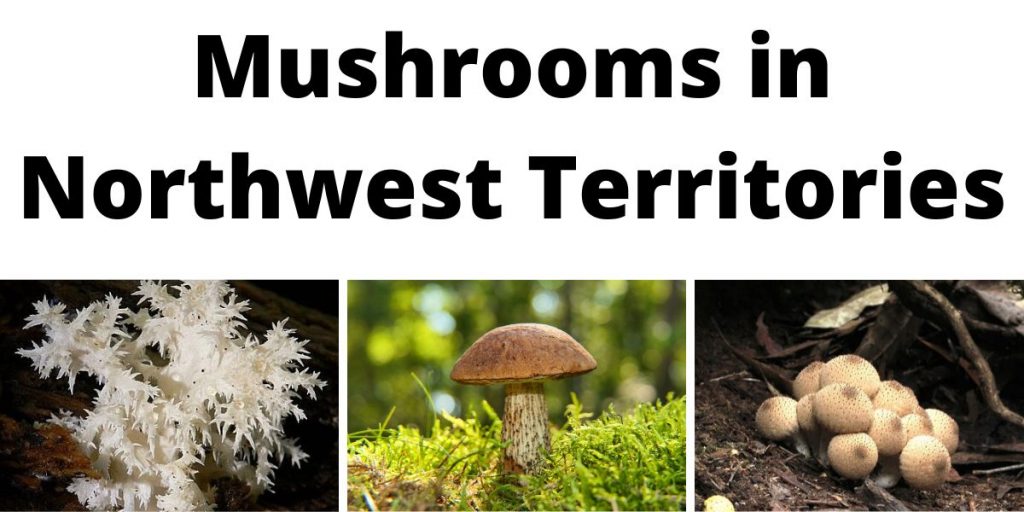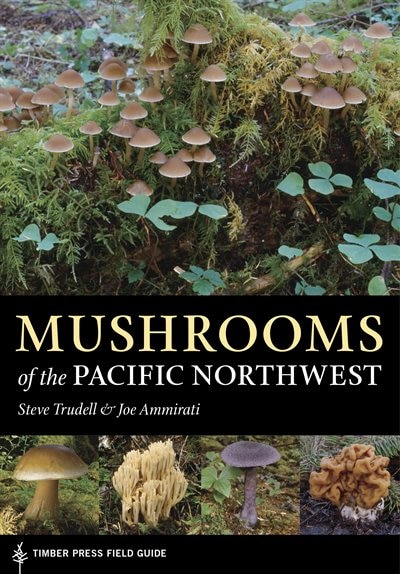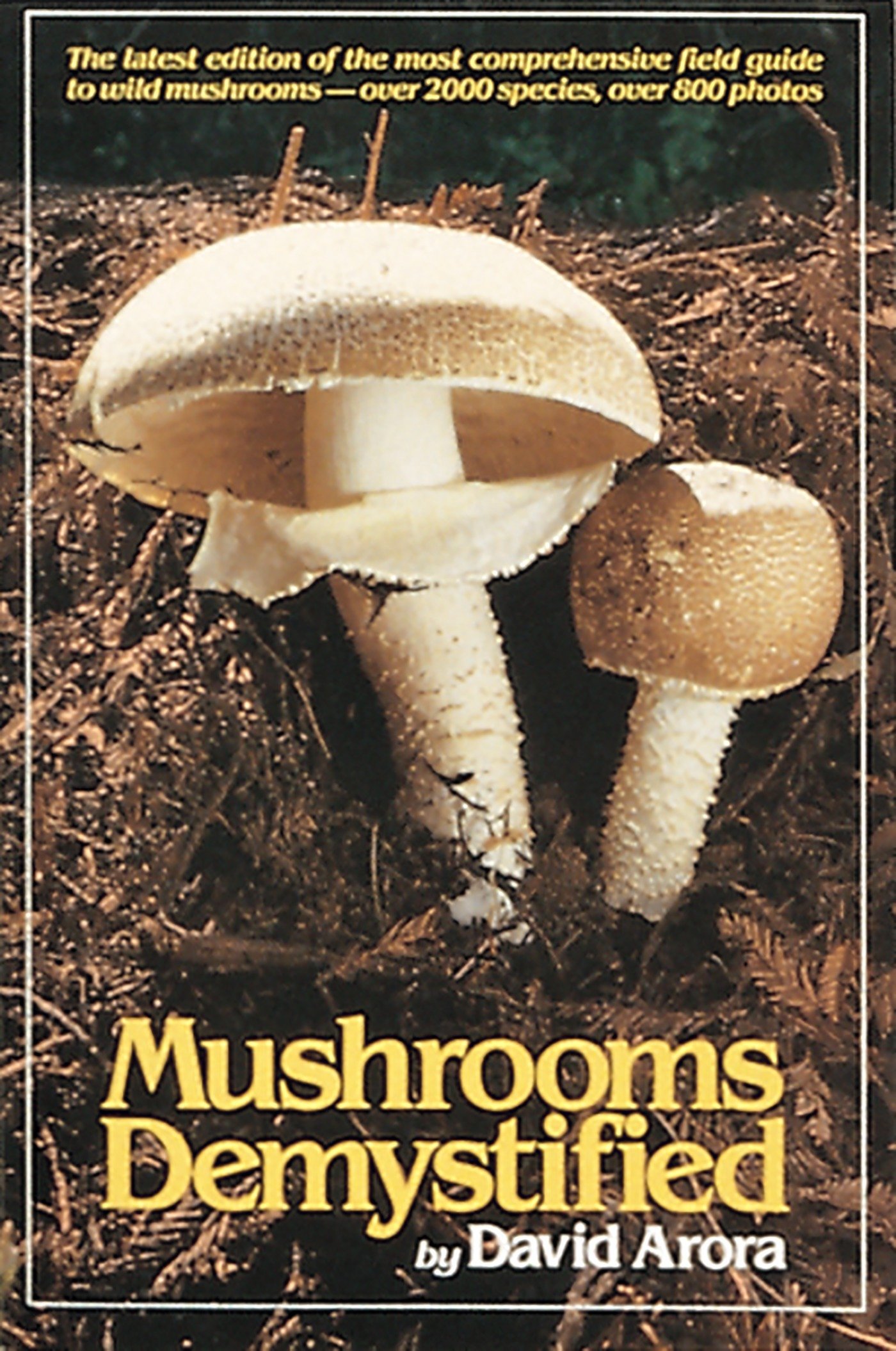Northwest Territories[i] is aptly-named, and much of it in tundra—which may be why the list of fungi sighted in the territory is almost all lichens (lichenized fungi are very cool, but don’t produce mushrooms). It’s difficult to find exhaustive lists, so it’s hard to be sure, but Northwest Territories may indeed have fewer mushroom species than most other parts of Canada. We haven’t even been able to find confirmation of any psilocybin-containing species.
Still, there are many fascinating species that do live here[ii]. We still can’t include all of them. We can tell you about a few of the ones you might like to eat—and a few that you definitely should not.
Becoming a forager takes far more study than an article on the internet can provide. We can give you an idea of what’s out there, though—and anyway, mushrooms are fascinating, and often beautiful, whether you eat them or not. This list is solely educational and should not be used as a substitute for a field guide, spore prints, or an identification app. When mushroom hunting, it is strongly recommended that you seek expert guidance in person. You should also bring a high-quality knife and a basket or bag.
Our Recommended Field Guides for the Northwest Territories
COVER | TITLE | Header | ||
|---|---|---|---|---|
OUR #1 RATED | ||||
Edible Mushrooms in Northwest Territories
Puffballs
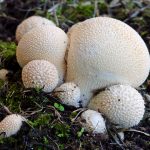

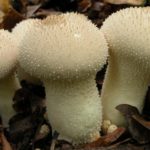

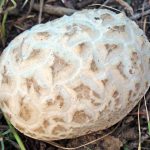

Puffballs look alike—they are all ball-shaped and puff out clouds of spores at maturity—so they were initially grouped together taxonomically. Turns out, they’re not all related to each other—some are as different as snakes and worms, same shape but totally different otherwise! But we still refer to puffballs as a group informally.
Many (not all!) puffballs are edible, though they look frighteningly similar to the early “egg” stage of some of the poisonous Amanitas. It’s always important to identify anything you plan to eat to species, but just to be sure, slice any puffball headed for the kitchen in half vertically to make sure it really is homogeneous inside (if it’s not, it’s not a puffball) and that the spores have not started to darken.
Northwest Territories has at least three edible puffballs, the Pear-Shaped Puffball (Lycoperdon pyriforme), the Common Puffball (Lycoperdon perlatum), and the Western Giant Puffball (Calvatia booniana), which very much lives up to its name.
Boletes
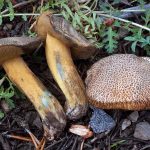

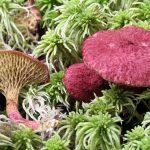

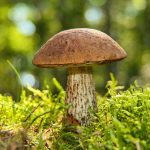

Boletes are a large group of fungi that all have fruiting bodies that have the classic, umbrella-like mushroom shape but don’t have gills. In place of gills, they have a flat layer of pores. Boletes actually are related to each other, but there are many different genera in the group, and the taxonomy is still being worked out.
Many (not all!) boletes are edible. Some are choice. Three of this region’s boletes are the Blue-Staining Slippery Jack (Suillus tomentosus), the pretty little Red Bog Bolete (Suillus paluster), and the Brown Birch Bolete (Leccinum scabrum).
Inkcaps
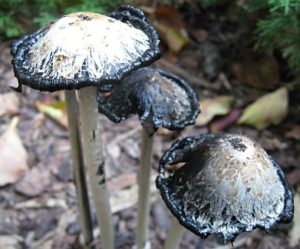

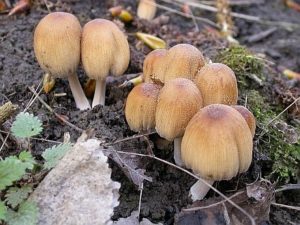

Inkcaps are another group of superficially similar non-relatives. Their claim to fame is that their fruiting bodies turn into inky goo at maturity. It’s not a very appetizing-sounding trait, but some inkcaps are edible when young and solid. In fact, even the ink can be used in cooking as an interesting food dye and flavoring. Shaggy Mane (Coprinus comatus) and Mica Cap (Coprinellus micaceus) are both good to eat and can be found in Northwest Territories.
Some experts list mica cap as poisonous because it causes temporary alcohol intolerance. But, really, if you can go for a week without drinking alcohol, this mushroom won’t hurt you.
Hericiums
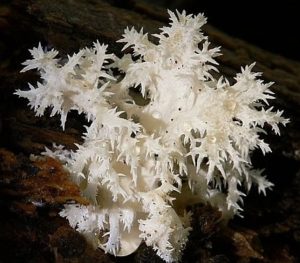

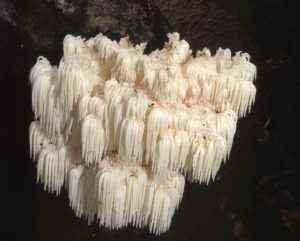

Hericiums are odd-looking fungi, for their fruiting bodies have no cap, no top or bottom, and are covered all over with white or whiting hairlike spines or teeth. They also taste a bit like crab meat, to the point of making a very credible crab cake. Northwest Territories has at least two. Coral Tooth (Hericium coralloides) has very short spines on its branches, and does look very much like certain kinds of coral. Note that this is not one of the coral fungi, an unrelated group that don’t look much like the coral tooth, but sound like them when described. Bear’s Head Tooth (Hericium americanum) has very long spines, to the point that its branching structure may be somewhat obscured. Imagine a pom-pom that forks.
Witch’s Butter (Tremella mesenterica)
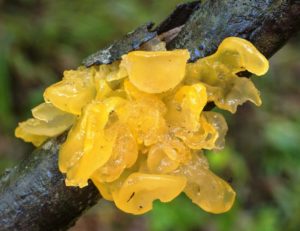

Witch’s butter (a common name also applied to other species, by the way) is safe to eat, but it doesn’t precisely have a taste. Nor does it look like a mushroom. Its fruiting body is a little orange blobby that will make your tongue tingle if you eat it. The main reason to eat this is for the occasional novelty of popping an odd little blobby in your mouth. Or, you could just spot it in the forest and pass it by, knowing what it is that that you could eat it, and feeling pleased.
Truncated Club (Clavariadelphus truncatus)
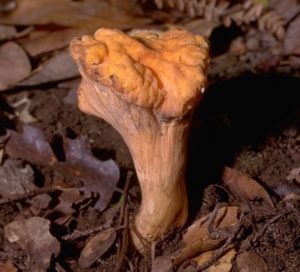

This one is also called the club coral, but “truncated club” describes it almost perfectly. It’s a sort beige color with a flat top and no distinct cap. It is related to the chanterelles, and vaguely resembles some of them, but only vaguely. It’s said to have a sweet flavor[iii].
Aniseed Funnel (Clitocybe odora)
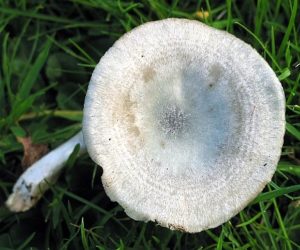

The aniseed funnel[iv] is often partially buried under leaf litter, but has such a powerful odor of anise that you might smell it before you see it. It’s not the only mushroom with that scent, but it may be the most powerful. Young specimens are a lovely blue. In time, the blue fades to an almost as lovely gray. It is said to pair especially well with fish.
Hawk’s Wing (Sarcodon imbricatus)
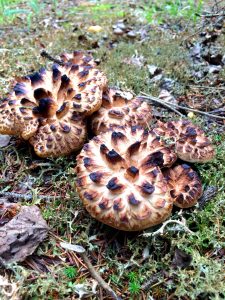

The upper surface of this mushroom is indeed mottled brown like the wings of many hawks. The underside of the cap has, instead of gills or pores, short teeth or spines. Hawk’s wing is a close look-alike of at least one popular edible (that may or may not grow in Northwest Territories, we haven’t confirmed) and is frankly not as choice, but you can eat it. The flavor is variable, from unpleasantly bitter to actually quite good.
Our Recommended Field Guides for the Northwest Territories
COVER | TITLE | Header | ||
|---|---|---|---|---|
OUR #1 RATED | ||||
Poisonous Mushrooms in Northwest Territories
Most mushrooms are not poisonous, and most of the poisonous ones aren’t dangerously so. Still, who wants to get sick? And who wants to take the risk getting a really bad risk? So poisonous mushrooms are important to know about and watch for. Note that many poisonous species are variably toxic, or toxic only under certain circumstances or to certain people. Some species may therefor be listed as poisonous by one authority and edible by another—judgment calls are required, another reason why inexperienced foragers who don’t yet have a lot of in-depth knowledge, should have the assistance of someone experienced.
Please remember, this list is not necessarily exhaustive—don’t assume a mushroom is edible just because it’s not listed here.
Brown Roll-Rim (Paxillus involutus)


Brown roll-rim is one of those species that you may be able to eat without difficulty, if you prepare it properly and get lucky. Should you decide the species is edible and start eating it on a regular basis, though, your luck will eventually run out. The poison is cumulative, and after months or years will suddenly make you very sick. You could die of it.
Western Jack O’Lantern (Omphalotus olivascens)
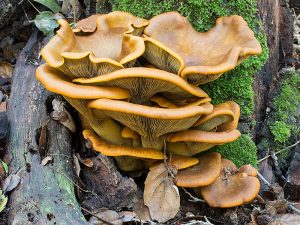

There are many jack o’lantern species, all very similar. This is the one you might find in Northwest Territories. They are reputed to glow in the dark, though some people have tried for years to see one glowing without success. They are also reputed to look like certain chanterelles, but chants don’t have gills and jack o’lanterns do. That they are poisonous is quite confirmed, though. If you eat one, you probably won’t die, but you’ll wish you hadn’t.
White Saddle (Helvella crispa)
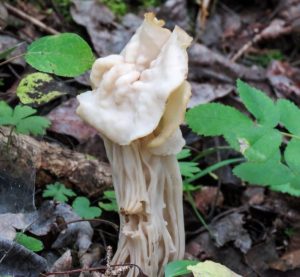

White saddle, which is mildly toxic when fresh, will probably not make you sick if you cook it very thoroughly, but by that point it will have turned to tasteless mush. It also could be carcinogenic. ‘Nuff said?
Fly Agaric (Amanita muscaria)
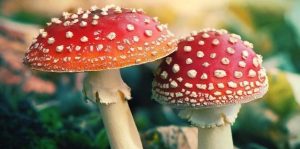

Fly agaric is often eaten on purpose as a mood-altering agent—it doesn’t contain psilocybin, but its quite different active ingredient can be used in a broadly similar way. But this is IF the mushroom is properly processed first. Make a mistake, and your trip will land you in the hospital. The poison itself is seldom lethal, just extremely unpleasant, but since poisoning victims are also high, they sometimes do ill-advised things and get hurt or even killed in the process.
So, to be clear, we haven’t put this species in the “poisonous mushrooms” section because it can get you high, but because if you do it wrong you’ll get very, very sick.
References:
[i] (n.d.). Northwest Territories. Wikipedia
[ii] (n.d.). Northwest Territories, CA. iNaturalist
[iii] Wood, M., Stevens, F. (n.d.). California Fungi—Clavaridelphus truncatus. Fungi of California
[iv] (n.d.). Clitocybe odora (Bull.) P. Kumm. –Aniseed Funnel. First Nature
Our Recommended Field Guides for the Northwest Territories
COVER | TITLE | Header | ||
|---|---|---|---|---|
OUR #1 RATED | ||||


